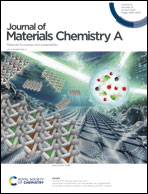Flexible and rigid spinel ferrite carboneous composite as a future of tunable absorption dominant cmWave shielding materials†
Abstract
In this article, a comparison of EMI shielding performance of rigid and flexible composites of cobalt nickel ferrite is done. Firstly, the rigid composites are synthesized using a regular ceramic route having three different multiwalled carbon nanotube (MWCNT) concentrations, which are denoted 3MWCNT/CNF, 6MWCNT/CNT, and 9MWCNT/CNF. In order to support their potential use as microwave absorbers in the microwave frequency range, the synthesized rigid composites are examined for their structural, morphological, electromagnetic, and microwave properties using X-ray diffractometry (XRD), field emission scanning electron microscopy (FESEM), vibrating sample magnetometer (VSM), and vector network analysis (VNA). The 9MWCNT/CNF composite exhibited the best shielding performance of 55.96 dB. Then, the prepared rigid composites were made into highly flexible films of varying thickness. The prepared flexible composites, and their essential EMI shielding parameters are simulated using CST Studio Suite Software, as well as measured experimentally. The agreement between simulated and measured values is exceptionally high. Furthermore, in comparison to traditional rigid composites, the fabricated flexible composites have superior shielding capabilities and operate in the X-band frequency range making them suitable for microwave and flexible technologies.



 Please wait while we load your content...
Please wait while we load your content...